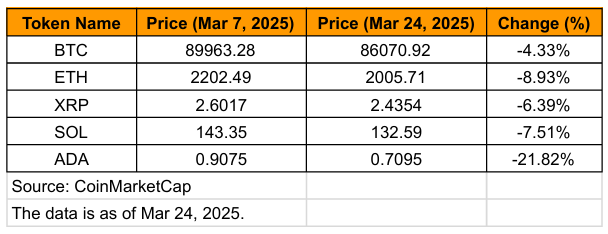I. Preface: The First White House Crypto Summit and Its Aftermath
On March 7, 2025, the White House held the first-ever "Cryptocurrency Summit" in history. Before the summit, the market generally expected the Trump administration to release significant positive signals, such as announcing additional Bitcoin purchases, incorporating more mainstream cryptocurrencies into the "National Crypto Reserve", or introducing clearer regulatory policies to continuously boost market enthusiasm and further stimulate market sentiment.
Influenced by this expectation, in the days before the summit, Bitcoin soared from $84,000 to nearly $95,000, and other mainstream cryptocurrencies (including ETH, XRP, SOL, ADA) generally rose 5%~25%.
However, after the summit officially convened, no large-scale purchasing plan or substantive new policies were announced, only reaffirming the existing stance of "supporting the industry with moderate regulation". As market expectations fell through, there was a significant pullback after the summit, with Bitcoin dropping approximately 3%~5% the next day, and other mainstream cryptocurrencies generally falling 5%~10%.
Nevertheless, compared to the comprehensive suppression by the previous government, the current policy and regulatory environment's significant relaxation still leaves the market relatively optimistic about long-term regulatory clarity and innovation space. Some investors remain cautiously optimistic about the future evolution of U.S. policies in the crypto domain.
To deeply understand this summit and its subsequent market fluctuations, we need to review the U.S. government's regulatory path and policy evolution in the crypto field in recent years. This article will provide a comprehensive analysis of the market trends before and after the summit, outline key policy signals, and explore the far-reaching impacts of this summit from an industry perspective.
Trump's Brief Attendance:
- Trump himself only participated for about 30 minutes at the beginning of the summit, and during the live broadcast, he told the participating crypto entrepreneurs that "the previous government's war on cryptocurrencies has ended" and emphasized that the government would provide regulatory certainty for the crypto market at the legislative level.
- The subsequent closed-door discussion was led by White House officials such as David Sacks, the head of Crypto and AI Affairs, and Treasury Secretary Scott Bessent. Many attendees (including former CFTC Chairman Chris Giancarlo, MicroStrategy founder Michael Saylor, Paradigm partner Matt Huang, and Robinhood CEO Vlad Tenev) made suggestions, including having the government buy large amounts of Bitcoin, tokenizing traditional securities assets, and re-examining criminal charges against Tornado Cash developers. However, these suggestions did not immediately receive any promises or guarantees.
A "Friendly but Light Touch" Regulatory Tone:
- Trump reiterated at the meeting that he would promote the development of the crypto industry through "friendly legislation and light-touch regulation".
- Although representatives from the Treasury and SEC did not explicitly promise to withdraw more lawsuits, they stated that they would prioritize the industry's needs in the future.
- The summit did not release any new executive orders or immediate bills, indicating that the government is still in the stage of "collecting industry opinions and discussing regulatory details".
Mainstream Media's Interpretation:
- Mainstream financial media (such as CNBC and Bloomberg) focused more on Trump's willingness to provide "regulatory certainty for the crypto market" through congressional legislation, believing that compared to the previous situation filled with gray areas and litigation, there has been a significant improvement.
Overall, this summit "set the broad direction but lacked specific details", and the short-term market impact was more about the disappointment of "expectations being disproved" rather than a disruptive positive development.
V. Market Trends and Technical Analysis After the Summit
After the summit, Bitcoin and most mainstream cryptocurrencies experienced a correction. The main reason was the market's rapid digestion of the "gap between expectations and reality", leading to short-term selling pressure, with many investors choosing to sell or temporarily wait and see.
The table below shows the price trends of several major cryptocurrencies from the end of the summit (March 7) to late March (March 24):

Overall, the market sentiment returned to rationality from the optimistic policy expectations and began to correct for "overly high expectations".
After losing the expectation of "government additional purchases", Bitcoin experienced a short-term pullback but has not yet seen a breakdown; Ethereum and XRP also followed the overall market trend downward, and most other mainstream cryptocurrencies are in a state of "ending short-term gains, entering oscillation or correction". In the derivatives market, funding rates have turned neutral or slightly negative, and the number of open contracts has decreased, reflecting the current decline in long-side leverage willingness and short-term speculative sentiment. Solana, due to the CME futures and ETF listing in mid-March, showed a slight counter-trend increase, creating a certain independent market trend.
Although there is a short-term pullback, against the background of significantly reduced long-term regulatory risks, many institutions and long-term investors still remain optimistic about potential future specific legislation or guidelines in the United States. Therefore, after a period of calm, the market still has the opportunity to re-gather buying momentum if the government announces specific policy benefits in the future.






